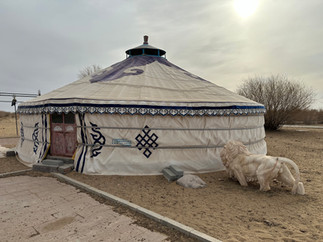Curious about exploring "Inner Mongolia" as autonomous part of China? Then read the below for an initial orientation framework!
During my trip through China, I had the privilege of exploring Inner Mongolia for a few days, together with two Chinese friends of mine. Not knowing what to expect, I plunged headfirst into a promising adventure that gave me a memorable and beautiful memoir I have never regretted. Extensive, untouched grass steppes, desert landscapes criss-crossed by dune hills, breathtaking river and lake landscapes, as well as cultural treasures and historical journeys through time into the life of the nomadic tribes make Inner Mongolia a true travel gem that has, so far, only rarely been noticed by non-territorial tourists.
Inner Mongolia vs. Mongolia: what's the difference?
I would assume that most of us are familiar with the independent country of Mongolia itself. What some of us don't know, however, is that Inner Mongolia is an autonomous region in northern China that runs along a narrow strip from northeast to southwest on the borders of Russia and independent Mongolia.
How to get to Inner Mongolia?
You can reach Inner Mongolia by train, car or plane. The quickest way, which I also recommend, is to simply step on a plane from China (Air China, China Eastern, Hainan Airlines), which will bring you to Inner Mongolia in less than three hours. Alternatively, you can take a train from Beijing to Baotou ( expected travel time ranges between 10 - 17hrs).
Population, Ethnic Diversity & Currency
The official population of Inner Mongolia was estimated around 24,000,000 people in 2022 and is characterized by both ethnic-, and cultural diversity. These include, for example, Mongols, Han, Hui, Manchurians, Dahurs, Evenki, Orogens and Koreans.
Although the majority of the population is dominated by Han Chinese, aspects of Mongolian culture, such as customs, clothing, language and food, remain prominent to this day. Traditional yurt tents, historical insights into the times of the nomadic tribes, as well as historical relics can be admired and explored in various museums. A visit is definitely worth it!
The official languages are Mongolian and Chinese, with Chinese now gaining more importance due to the increasingly declining use and language proficiency of ethnic Mongols. This is also due to the fact that the Mongolian language is not taught further from middle school onwards.
The official currency is Thugruk.
Keyword Communication: what about English?!
Anyone who thinks that China is a challenge when it comes to communication barriers will have to prepare for an even higher level of language difficulties in Inner Mongolia. English is practically not spoken here at all. This also applies to traffic signs on the streets, menues in restaurants or museum explanations. Nevertheless, despite the language barrier, you are always warmly welcomed and looked after. If it doesn't work verbally then use hands, feet, translators or even pictures. You find your way to communicate, even if it sometimes takes a little more time than usual.
In any case, I would highly recommend to ensure having a stable internet connection to get ahold of translation apps, especially in case you decide to travel on your own and/or cannot speak Chinese to ease the overall communication process and travel experience.
Local Tourism: Hollywood Status as a Westerner
Most tourists on site mainly come from China. This is quite understandable given the fact that Inner Mongolia, with its diverse landscapes, offers a place of peace and relaxation, especially for residents of large Chinese cities.
Western tourists are a rarely seen phenomenon and are usually associated with great astonishment and fixed stares. It is not uncommon for the polite question of a shared selfie to cross your path.
Finding the right accommodation
The hotels in Mongolia literally took my breath away. Never have I ever seen such spacious rooms, equipped with everything you could wish for, leaving room to freely dance aorund your room or do some morning workouts, if desired. Spacious hallways, breakfast buffets and breakout areas are to be found in nearly every hotel you go to. And the choice is plentiful: whether you decide to stay in a bigger city, camp outside in the desert or have a sleepover in a traditional yurt tent under the stars, each accommodation will have its own charme for you to enjoy and experience.
But be careful: Not all hotels accept tourists outside of China! Therefore, in the case of self-organized trips, you should arrange your bookings always in advance to be on the safe side. It was not uncommon for me to be rejected at the recpetion desk, being asked to move and try at another hotel in the close surroundings. The reason behind? I honestly cannot tell you and neither could my Chinese friends. However, as Inner Mongolia is planning on enforcing more marketing campaigns for tourists to enter their country, hotel bookings might become easier in the near future.
How to get around Inner Mongolia?
Due to the width of the country and diversity of landscapes, the best way to explore Inner Mongolia is by car or bus.
Do I need a visa?
As an autonomous region of China, visa requirements for Inner Mongolia are the same as entering China mainland itself. For more information click here:
To conlcude: is it worth going to Inner Mongolia?
My answer to you is YES! Why? Because Inner Mongolia will open up a totally new insight of China you have not yet come across so far. From wide deserted grass lands to green overgrown river landscapes and hilly golden-brown sand dunes- Inner Mongolia is must-do travel experience for all nature lovers and adventurers. Enjoy the tranquility amongst seemingly endless rides along barren steppes, taste the traditional hot pot with a variety of local meats, connect with locals by enjoying a traditionally saltened milk tea and visit historical-enriched sightseeing spots, monuments and museums. I am certain it will be a unique, life-changing experience!
Want to know more about top sightseeing must-do's and traditional cuisines to try? Then keep on reading and follow my articles!































Opmerkingen